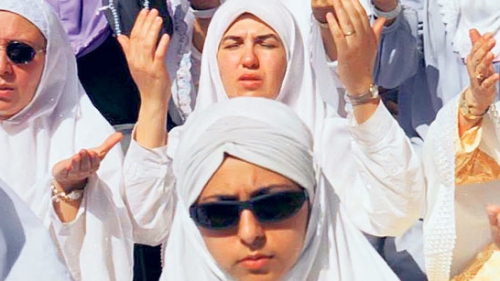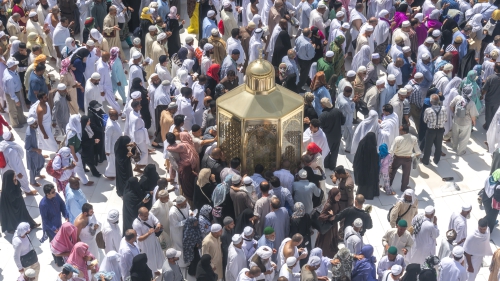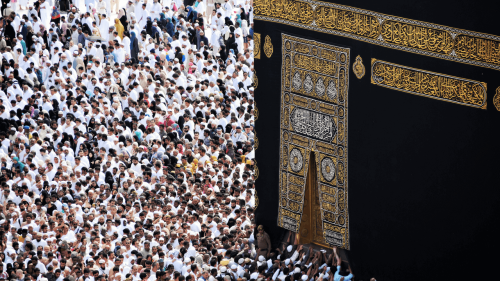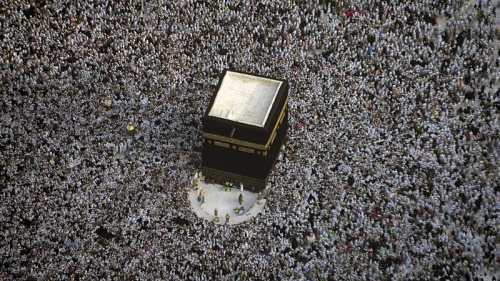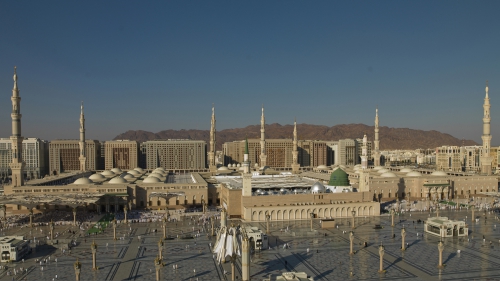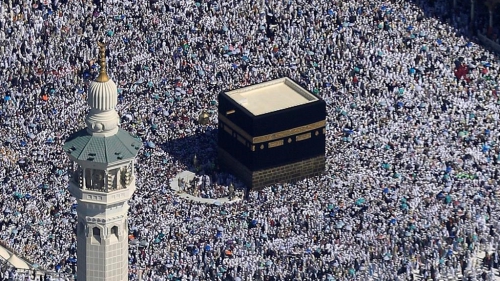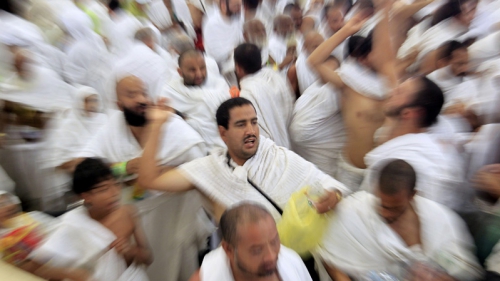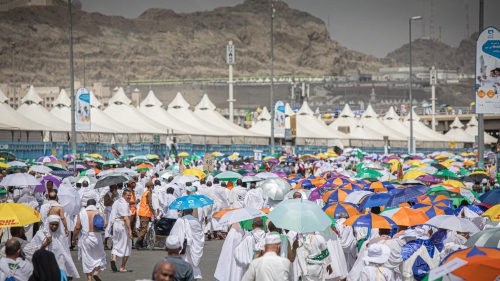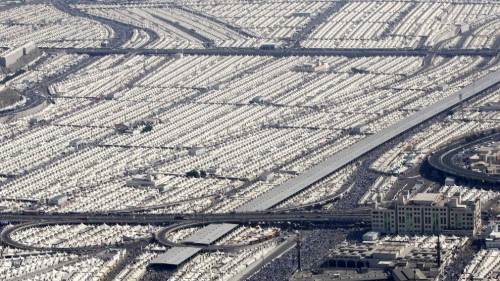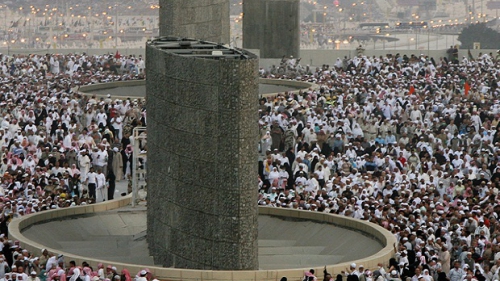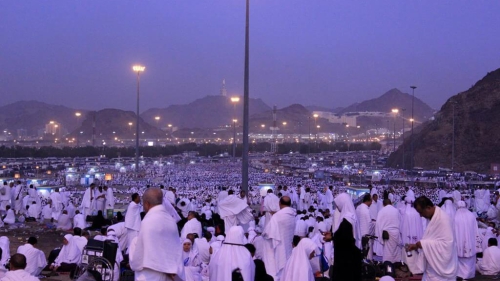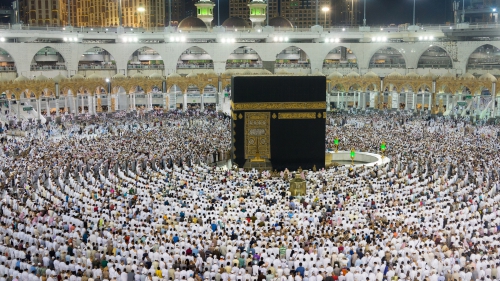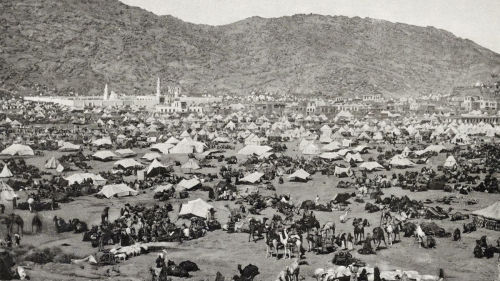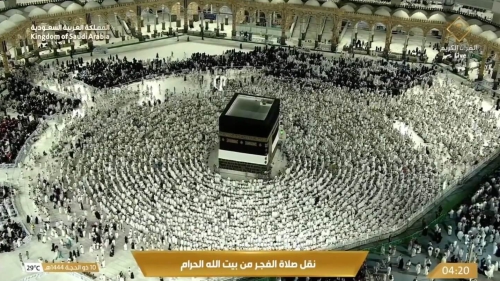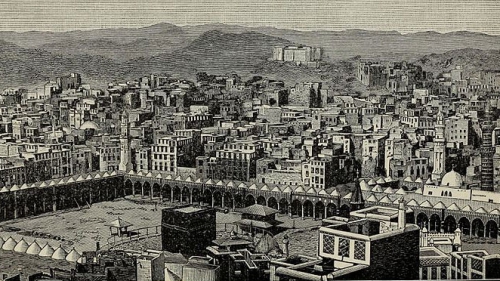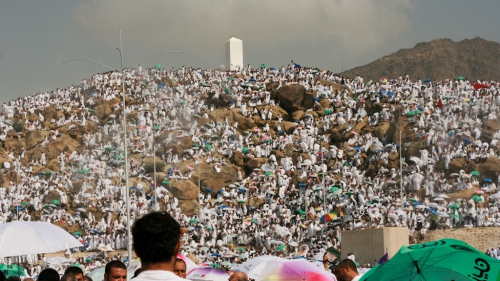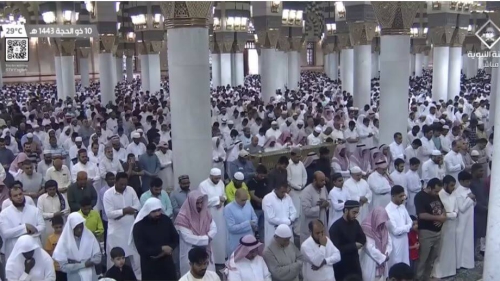The Spirituality of Hajj: Muzdalifah

After the sunset of the 9th of Dhul Hijjah pilgrims move on to Muzdalifah. There they spend the night. Firstly they pray the Maghrib (sunset) and ‘Isha (night) prayers together. Having combined them, they also shorten the latter from four to two units (rak’ah). It is in accordance with a confirmed practice of the Prophet (pbuh) that one should sleep after the prayers until dawn, when the Fajr (dawn) prayer is to be performed. The Prophet (pbuh) is not reported to have executed any voluntary prayers or any other tangible acts of worship before dawn.
After the Fajr prayer during the earliest part of its time - i.e. as soon as dawn appeared - the Prophet (pbuh) moved towards a hill at Muzdalifah called al-Mash’ar al-Haram. He stopped there and, having faced the qiblah, performed dhikr and supplication to God. He did so solemnly. He remained in this condition until there was light all around. Then, just before the sunrise, he left for the last stopover of Hajj: Mina.
It should be emphasized that just like ‘Arafah, all Muzdalifah is a place of standing, so wherever a pilgrim stands after the Fajr prayer, remembering Allah and supplicating to Him, then it is permissible. To most scholars, al-Mash’ar al-Haram accounts for all Muzdalifah; they are synonymous. In addition, most scholars are of the opinion that spending the entire night at Muzdalifah is not obligatory, especially for those who might have valid excuses relating to age, health and provision of services for pilgrims.
However, stopping at Muzdalifah, performing the Maghrib and ‘Isha prayers and spending afterwards some time of the night there, approximately until after midnight, is obligatory. The Prophet (pbuh) allowed elderly people, women and those who were in charge of certain services for pilgrims to leave early. At Muzdalifah, a pilgrim also collects pebbles for the ritual of stoning the jamarat (symbolically, the devil) later at Mina, which nevertheless can be done at Mina itself or at a nearby place. Talbiyah is still to be recited whenever possible until the first pebbles are thrown at Mina.
Departing from ‘Arafah to Muzdalifah and remembering God there, and subsequently departing to Mina, has been referred to in the Qur’an: “But when you depart from ‘Arafah, remember Allah at al-Mash’ar al-Haram. And remember Him, as He has guided you, for indeed, you were before that among those astray. Then depart from the place from where (all) the people depart and ask forgiveness of Allah. Indeed, Allah is Forgiving and Merciful” (al-Baqarah, 198-199).
Muzdalifah is normally defined as a place between ‘Arafah and Mina, the former being the farthest of the three from, and the latter the nearest to, Makkah. As one keeps performing Hajj, one likewise keeps moving towards Makkah. In essence, he keeps returning to it, having started the Hajj journey from there. The whole movement is qiblah-oriented.
‘Arafah lies east of the city of Makkah, so pilgrims keep advancing in company with the sun. It seems as though the sun, a magnificent sign of Allah, illuminates and directs the army of pilgrims and is on a Hajj mission itself. “Therefore, the sun is also performing Hajj; it rises in ‘Arafah, passes from al-Mash’ar al-Haram and enters Mina.” 1Ali Shariati, Hajj: Reflections on Its Rituals, p. 77. The situation is not corresponding to the principle of having “the wind in one’s back”, but rather to the principle of “enjoying the rays of, and walking on, sunshine.” In actual fact, nothing compares to the power and symbolism of the sun.
Unlike ‘Arafah, Muzdalifah is part of the haram (sanctuary) of Makkah. As a sacred territory, it is strongly advisable that pilgrims enter it in a state of ritual purity. Some scholars go so far as to suggest that if a pilgrim is able to enter Muzdalifah on foot, it is better and more respectful of the sanctuary. On the way to Muzdalifah, talbiyah is to be chanted intently and loudly, so as to reciprocate the circumstance.
Being in the state of ritual purity and being mindful of the implications goes a long way towards the realization of a state of spiritual purity. Entering Muzdalifah in such a way prepares a pilgrim for what awaits him there. He must be prepared and equal to the tasks. Doing so lays the groundwork for making the most of what Muzdalifah offers.
If Muzdalifah is located geographically between ‘Arafah and Mina, so are its Hajj rites placed between the rites of the two. Its rites function as a transitional point from ‘Arafah to Mina. In respect of their impact, they connote the conclusion of the former and, as such, a prelude to the latter.
Thus, to some extent, Muzdalifah is a mode of rest and breather for pilgrims, who have spent the day at ‘Arafah in complete absorption while trying to take full advantage of the occasion. The following day at Mina (the 10th of Dhul Hijjah, which is also the day of ‘Id and sacrifice) is perhaps most demanding physically and emotionally on pilgrims, inasmuch as a series of mandatory rites need to be accomplished. Scholars spoke about the order in which these rites are performed, and about the consequences of not observing the prescribed order.
Picking up pebbles at Muzdalifah for the “battles” at Mina galvanizes the effects of ‘Arafah – and of the whole Hajj hitherto fulfilled – and primes pilgrims for the march and the campaigns ahead. Spending the night at Muzdalifah quietly and basically alone affords pilgrims an opportunity to embark on the crucial stage of dissecting and soaking up what has just transpired at ‘Arafah. The day of ‘Arafah might be too pulsating and too “short” to accomplish the same then and there. A post-internalization period is needed.
Muzdalifah rests the body, sharpens the mind and further kindles the soul. The Qur’an recaps the process using the following idioms “departing from ‘Arafah to Muzdalifah”, “remembering Allah (dhikr)” and “asking the forgiveness of Allah”. Either a segment of Muzdalifah, or the entire location, is identified in the Qur’an as al-Mash’ar al-Haram, meaning “the Sacred Monument or Waymark”. However, linguistically the word “al-mash’ar” is derived from the root words that denote “feeling”, “perception”, “sense”, “experience” and “knowledge”. Yet, one of the distant meanings of the word “al-mash’ar” itself is “any of the special bodily faculties by which sensation is roused”. 2Mash’ar, https://www.almaany.com/en/dict/ar-en/%D9%85%D8%B4%D8%B9%D8%B1
At Muzdalifah the body functions as the container of substance and the carrier of emotional and spiritual protocols. Its sensory knowledge and experiences are the portal to another meta-experiential and meta-cognitive dimensions. Such indeed is a sacred state, in the same way as the al-Mash’ar and the total being of a pilgrim are. In its broadest sense, al-Mash’ar al-Haram stands for both “the Sacred Monument” and “a sacred (emotional and spiritual) state”.
Complementing the meanings of al-Mash’ar al-Haram, linguistically Muzdalifah is derived from the root words that signify “approaching”, “bringing near” and “advance”. Muzdalifah, therefore, is so called because while arriving from ‘Arafah to Muzdalifah, pilgrims get nearer to Mina and to the point of completing Hajj. The name also implies that Muzdalifah is another sacred location where pilgrims worship God and so, get closer to Him and His pleasure. The worship acts associated with Muzdalifah are further steps that help pilgrims in their spiritual ascension. They embody growth and maturity.
A pilgrim advances and gets closer to the truth, his Creator and his very self. This, concurrently, is his celestial reason for existence. Ever more he makes discoveries concerning those and concerning how close and harmonious his relationships with them are. He utilizes the sixth sense aroused at Muzdalifah – and during Hajj in general – to perceive what otherwise he could not perceive, and to act.
What takes place at Muzdalifah is a profoundly personal undertaking for which night-time, relative solitude and peace - as the background of Muzdalifah - are supremely conducive. Laying out some initial strategies in the interest of optimizing the ‘Arafah effect for the future, starting with the looming actions at Mina, can also be carried out. Such can be no more than in the manner of creating some general strategic frameworks or blueprints. Muzdalifah is not for industry and over-elaboration. Rather, it is for epiphanies and insights.
The night of Muzdalifah obscures the properties of the material world and let loose those of the spirit and consciousness. The working of the former is curtailed and that of the latter exhilarated, to such an extent that a pilgrim’s body sleeps but his soul is awake.
Sleep is a blessing for the believers ahead of battles and when in distress. It causes hearts to feel secure, safe and sure of Allah’s aid. Without a shred of doubt, while staying at Muzdalifah, pilgrims ready themselves for the looming battles, some of which are short-, others medium- and yet others long-term. Their sleep is at once functional and symbolic.
By way of illustration, on the occasions of the historic battles of Badr and Uhud, sleep (slumber) overcame the Muslim warriors, whereby they were handed divine help and were guaranteed favours. The Qur’an says about the battle of Badr: “Remember He covered you with a sort of drowsiness (slumber), to give you calm as from Himself, and he caused rain to descend on you from heaven, to clean you therewith, to remove from you the stain of Satan, to strengthen your hearts, and to plant your feet firmly therewith” (al-Anfal, 11).
To Ali Shariati, the daylight of ‘Arafah exemplifies experience and objectivity, and the night of Muzdalifah insight and subjectivity. ‘Arafah furthermore is a state of mind that feeds on empiricism and science, whereas Muzdalifah is a state of soul that feeds on the inward dimensions and esoteric expressions of faith.
“‘Arafah is representing the stage of knowledge and science which is an objective relationship between the thoughts and the existing facts of the world. Clear vision is necessary; therefore, it needs light (daytime). Mashar (Muzdalifah) represents the stage of consciousness which is a subjective relationship between thoughts. Therefore, it is the power of understanding achieved by more concentration in the darkness and the silence of night-time.” 3Ali Shariati, Hajj: Reflections on Its Rituals, p. 65.
Muzdalifah blinds, but also illuminates; it veils, but also uncovers. What cannot be recognized in an environment, can be in another. A mood and competence affiliated with the latter are different from those affiliated with the former. Instead of competing, or trying to outdo one another, dissimilar environments should find ways to work together, maximizing strengths and minimizing limitations. Certainly, ‘Arafah and Muzdalifah are two environments that despite having much in common, are likewise dissimilar in more ways than one.
This is akin to the ways Prophet Ibrahim dealt with his adamant polytheistic people. Among other strategies, Ibrahim used the clarity and intelligibility of daylight to bring home certain doctrinal messages. However, in order to make his case clearer and more intelligible, Ibrahim resorted to the latent promises of night-time as well. His intention was to elevate his arguments to the higher levels of reasoning – and existence - and to thus throw more “light” on the thorny questions.
The Qur’an says that when the night covered Ibrahim in darkness, he was able to see and reflect upon a star and upon the moon rising in splendour. These visions, and insights stemming therefrom, have been perfected by Ibrahim’s subsequent vision of and reflection upon the sun rising in splendour. Which conveys the importance of the alternation of night and day, and of their complementing each other in relation to the attainment of spiritual, emotional and intellectual excellence. It is one of the self-evident regulations that what the day covers the night reveals, and what it uncovers the night veils.
The Qur’an asserts that through this approach Ibrahim himself was shown the power and laws of the heavens and the earth, and as a result, he became yet more grounded in the certainty of faith. Following the success of the plan, Ibrahim declared to his compatriots and also to himself: “O my people, indeed I am free from what you associate with Allah. Indeed, I have turned my face toward He who created the heavens and the earth, inclining toward truth, and I am not of those who associate others with Allah” (al-An’am, 75-79).
Prophet Muhammad (pbuh) alluded to the immediate functionality of the ‘Arafah effect as soon as he was leaving ‘Arafah for Muzdalifah. He advised that pilgrims should move calmly and at an unhurried pace. Rushing right and left – as some people did - and compromising certain elements of the Islamic decorum in the process, was prohibited. 4Ahmad bin Hanbal, Musnad Ahmad bin Hanbal, Book 4, Hadith No. 117.
Abu Hamid al-Ghazzali further elaborated on the matter when he said that aside from moving to Muzdalifah calmly and quietly, pilgrims should also avoid agitating horses and inciting camels, for the Prophet (pbuh) forbade doing so, saying: “Fear God and proceed gracefully. Do not tread on a weak (person) and do not harm a fellow Muslim.” 5Abu Hamid al-Ghazzali, The Book on the Secrets of Pilgrimage
Due to the intermediate and somewhat transient character of the Hajj rite of standing at Muzdalifah, the same is often misunderstood by many people. Several misconceptions and practical mistakes - small and huge - have been concocted.
For example - as said before – some people tend to rush to Muzdalifah in a helter-skelter mode, without paying attention to what is happening around them and why exactly they are on the move. The idea is just to keep moving regardless, and to steal a march on others. They – even though unconsciously - turn the occasion into a scramble and even a race.
The Prophet (pbuh) left ‘Arafah in a peaceful and dignified manner. “He pulled the reins of his she-camel al-Qaswa’ tight so that her head touched the saddle (in order to keep her under perfect control), and he gestured to the people with his hand to slow down. But when he found an empty space ahead of him, he would hasten, and whenever he happened to pass over an elevated tract of sand, he slightly loosened (the camel’s reins) till she climbed up. The Prophet (pbuh) paid attention to what was going on in this journey, but if it is the matter of a choice between going quickly and taking one's time, then taking one's time is preferable.” 6Mistakes Made on the Way to Muzdalifah and in Muzdalifah
Moreover, some people have a tendency to stop and stay (stand) outside the parameters of Muzdalifah, conceivably because they are too tired, misinformed, or simply ignorant. Others tend to pray the Maghrib and ‘Isha prayers in a usual manner before arriving at Muzdalifah, while some others – contrariwise - do not pray even if their arrival is so late that it takes place after the prescribed time of the ‘Isha prayer.
The Fajr prayer is often affected too. Some pilgrims perform it before its stipulated time in order to race to Mina and hence, beat others to it. Other pilgrims perform the Fajr prayer on time, but mismanage the time after it to the point that they leave Muzdalifah well after the sunrise. And yet others have a propensity for not spending the minimum period of time required at Muzdalifah. Some just pass through the place without even stopping. They believe that Muzdalifah is nothing but a bridge between ‘Arafah and Mina, with naught or extremely little to be done there. 7Ibid.
What is more, there are those who misunderstand the Prophet’s conduct at Muzdalifah and take it to extremes. If the Prophet (pbuh) is reported to have not performed any voluntary prayers or any other tangible acts of worship between the Maghrib and ‘Isha prayers and the Fajr prayer, this does not mean that a person should be inert and unconcerned utterly, especially during the windows of opportunity that exist throughout the night. Such windows are the time – notwithstanding its briefness - between the Maghrib and ‘Isha prayers and one’s formal going to sleep, the time between one’s waking up and getting ready for the Fajr prayer, the time(s) between sleeping intervals, if a person for specific reasons cannot spend the entire night sleeping: if he is sick, uncomfortable, insomniac, or simply overexcited.
To be too passive when opportunities present themselves at Muzdalifah is as much against the Sunnah of the Prophet (pbuh) as is staying up the whole night for voluntary prayers, recitation of the Qur’an, dhikr, offering supplications, etc. This is what Abu Hamid al-Ghazzali had in mind when he said that burning the midnight oil during the exalted night of Muzdalifah is among the best acts of devotion for those who can afford it.
Finally, in the pre-Islamic times there existed a number of fallacies associated with Muzdalifah and the religious ceremonies carried out within its ambit. However, the following fallacy stands out, to which the Qur’an refers as well. Allah says: “Then depart from the place from where (all) the people depart and ask forgiveness of Allah. Indeed, Allah is Forgiving and Merciful” (al-Baqarah, 199).
In the commentary of this verse, the exegesis of the Qur’an highlight, firstly, that “departing” means that those people who stand at ‘Arafah should move to Muzdalifah to remember God there (at al-Mash’ar al-Haram). This is a view of the majority. The minority of scholars opine that “departing” means from Muzdalifah to Mina. However, the Qur’anic injunction could mean both: from ‘Arafah to Muzdalifah, and from the latter to Mina, for the three signify the three stages of the same movement (progression and growth). And Allah knows best, as Ibn Kathir concluded his discussion of the subject. 8Ibn Kathir, Tafsir Ibn Kathir
Secondly, the exegesis of the Qur’an mentions that the pagan Quraysh during the time of ignorance (jahiliyyah) did not go to ‘Arafah as the rest of pilgrims did. ‘Arafah is not part of the sanctuary (haram) of Makkah so, the Quraysh preferred to remain within the haram near Muzdalifah, while the rest of people would go and stand at ‘Arafah.
The Quraysh invented this practice under the pretext that they were the people of Allah’s Town and the servants of His House. They were superior to others in status and their prestige was unquestionable. It did not behove them to exit the boundaries of the haram and to mix with other (ordinary) Arabs at ‘Arafah. Thus, Muzdalifah was converted into an avenue of bigotry and faithlessness. As expected, Islam annulled this deviation, just as it did annul all the erroneous beliefs and standards on which the former rested.
It was narrated that the Prophet’s wife ‘A’ishah said: “The Quraysh used to stand at Muzdalifah and they called themselves al-Hums, and the rest of Arabs stood at ‘Arafah. Then Allah, Blessed and Most High, commanded his Prophet to stand at ‘Arafah, and then move on from there. Allah, the Mighty and Sublime, revealed: ‘Then depart from the place whence all the people depart’ (al-Baqarah, 199).” 9Al-Nasa’i, Sunan al-Nasa’i, Book 24, Hadith 395.
“Al-Hums” is the plural of “ahmas”, meaning hardy or rigorous. It is said that this name was applied to the Quraysh because “they boasted of their bravery and endurance. Another explanation is that they observed the rites of standing only at Hamss, which is the Ka’bah.” 10Al-Tabrizi, Mishkat al-Masabih, Book 10, Hadith No. 94. And yet another interpretation is that al-Hums means “strictly religious”, and the Quraysh were called so because they used to say: “We are the people of Allah, we shall not go out of the sanctuary.”
Afterwards, united under the banner of Islam and the exemplary behavioural paradigm of the Prophet (pbuh), all people - including the Quraysh and the other residents of Makkah - were asked to go to ‘Arafah collectively as one and to depart from there and enter the haram of Makkah at the point of Muzdalifah also collectively and as one, in that Hajj – Islam in full - unites, not divides; it publicizes righteousness, not wickedness; and it is egalitarian, not class-conscious. ‘Arafah and Muzdalifah are designed to bring people closer to each other and to their Creator, rather than to repel and alienate.
How deep-rooted this aberration was testifies the following report. Narrated Muhammad bin Jubair bin Mut`im: “My father said: ‘(Before Islam) I was looking for my camel. It was lost and I went out in search of it on the day of `Arafah, and I saw the Prophet (pbuh) standing at ‘Arafah. I said to myself: ‘By Allah, he is from the al-Hums; what has brought him here?’” 11Al-Bukhari, Sahih al-Bukhari, Book 25, Hadith No. 145.
A series of articles adapted from the latest book by Dr. Spahic Omer, "The Spirituality of Hajj".
Footnotes
Topics: Hajj, Muzdalifah Values: Spirituality Channel: Hajj - Day 3
Views: 14345
Related Suggestions






